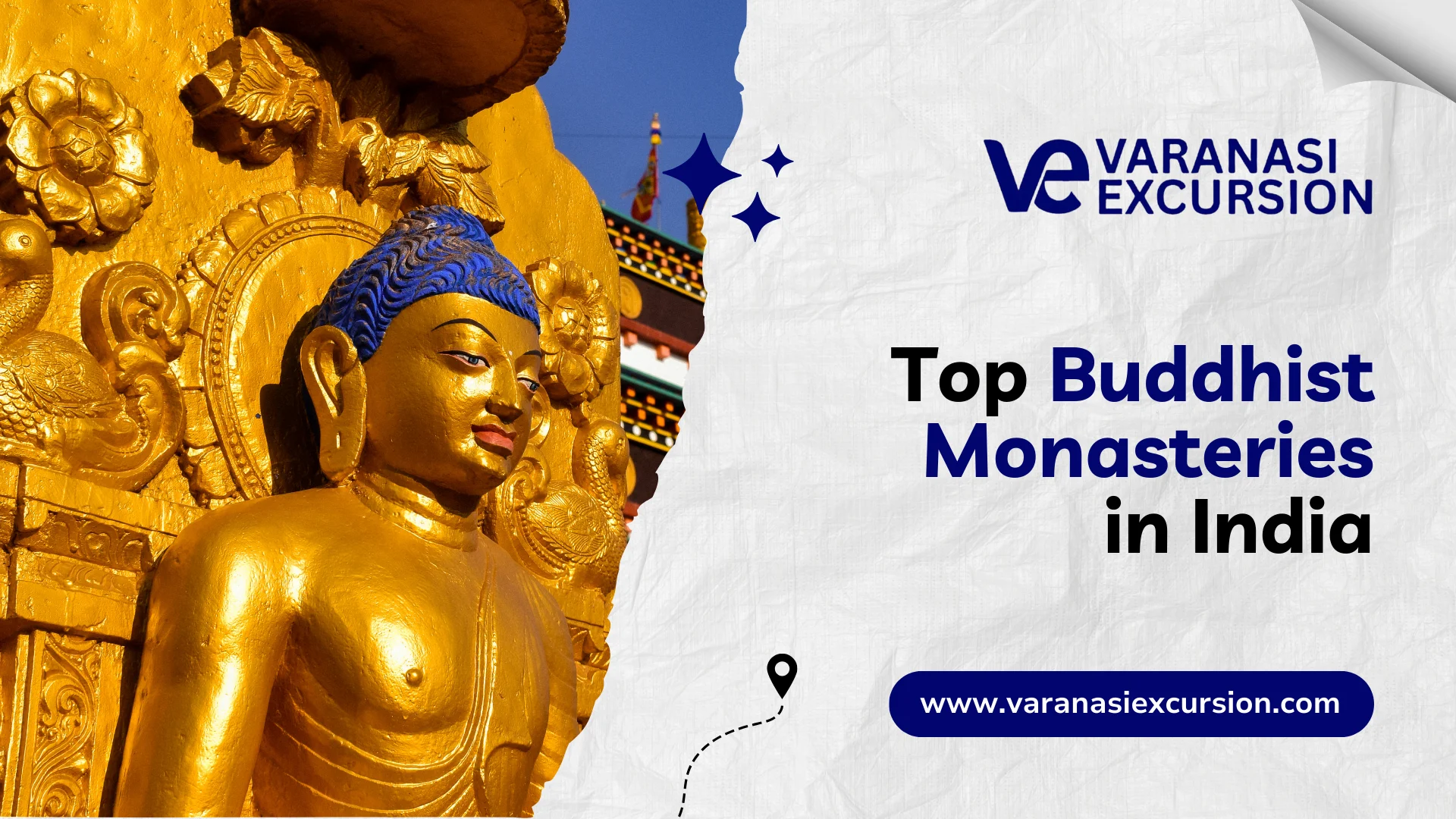When I was a child, whenever I felt worried or tired, I looked for quiet places.
Sometimes it was a park, sometimes it was just a small corner in my house.
At that time, I did not know why I did so, probably because I was seeking peace.
And today, when I was younger (not disclosing my age, probably you can guess when we meet for any Buddhist trip), I found the same peace I found in a monastery.
A monastery is a special place where monks live, pray, study, and teach.
You can think of it like a home and school together.
Here, monks follow the teachings of the Buddha. They practice meditation and keep alive traditions that are thousands of years old.
But monasteries are not only for monks. Travelers like you and me can also go inside. Some monasteries even let visitors stay for a short time. You can listen to the morning prayers or just sit quietly in the prayer hall.
When you enter a monastery, you will often see:
- Colorful prayer flags moving in the wind
- Big statues of the Buddha inside the main hall
- Monks in red or orange robes walking around
- Chants and drum sounds during prayer times
It is a mix of calm, color, and culture all in one place.
And the best part that I love the most is, you don’t need to be a Buddhist to visit. In India, monasteries welcome everyone who comes with respect and curiosity.
So today, I will take you through some of the best Buddhist monasteries in India. Whether you live in India or are visiting from another country, I will keep it simple, easy, and full of stories.
13 Buddhist monasteries in India that you must know
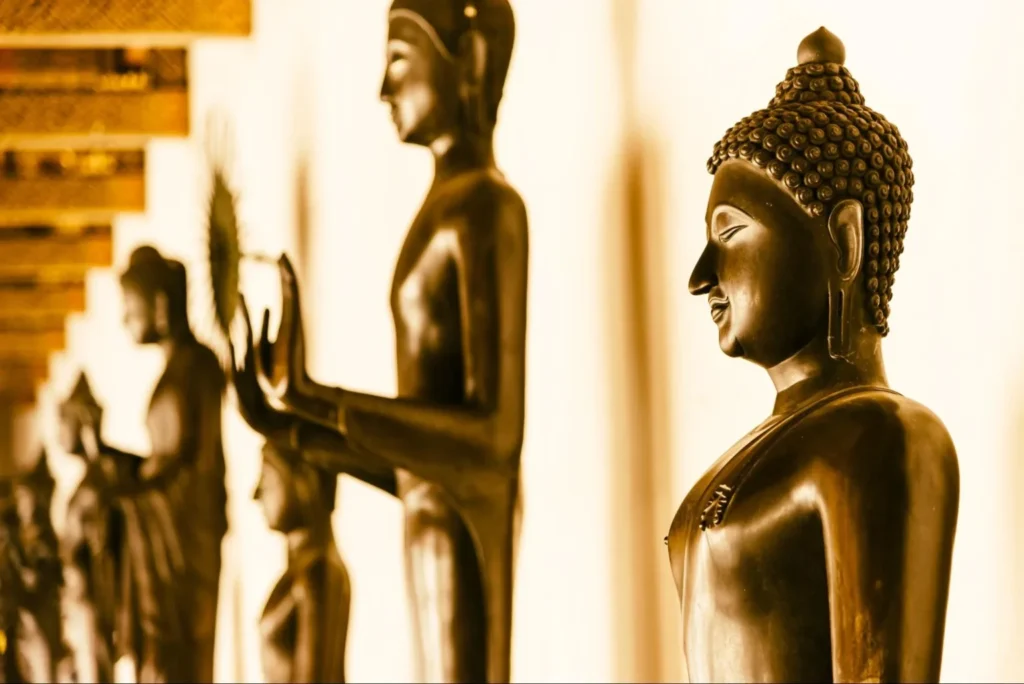
These monasteries are full of peace, learning, knowledge, and culture. Don’t trust me by my words; just go through the list below. By the end of this blog, you’ll definitely feel it and probably end up booking a tour in India. Let’s get started.
Hemis Monastery – Ladakh
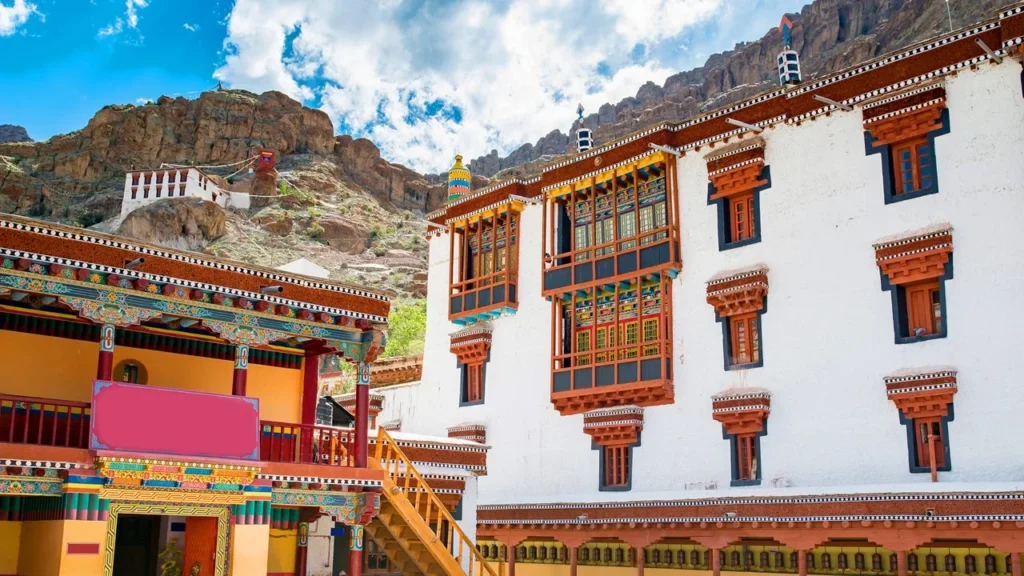
When I first saw Hemis Monastery, it looked like a white palace hidden in the mountains. It is about 45 km from Leh and stands at a height of 12,000 feet. It is the largest and richest Buddhist monastery in Ladakh.
First built in the 11th century and later rebuilt in 1630 by Stagsang Raspa Nawang Gyatso with the help of King Sengge Namgyal. The monastery follows the Drukpa tradition of Tibetan Buddhism and is very important for the Kagyu sect.
Special things about Hemis Monastery
- World’s largest thangka collection: You can see old Buddhist paintings, gold statues, and Tibetan books.
- Hemis festival: Every 12 years, a big festival is held to honor Guru Padmasambhava. People enjoy colorful Cham dances.
- Monastery museum: The museum shows old weapons, carvings, and religious items.
- 15-meter-tall Buddha statue: A huge statue of Maitreya Buddha is one of the main attractions.
Travel tips
- Best time to visit: From May to September, when the roads are open.
- Distance from Leh: 45 km (about 1 hour by car).
- Timings: Open from 7:00 AM to 7:00 PM.
- Stay options: Homestays and guest houses are available in Hemis village.
- Festival tip: The big Hemis Festival happens only once in 12 years, so plan well if you want to see it.
Tawang Monastery – Arunachal Pradesh
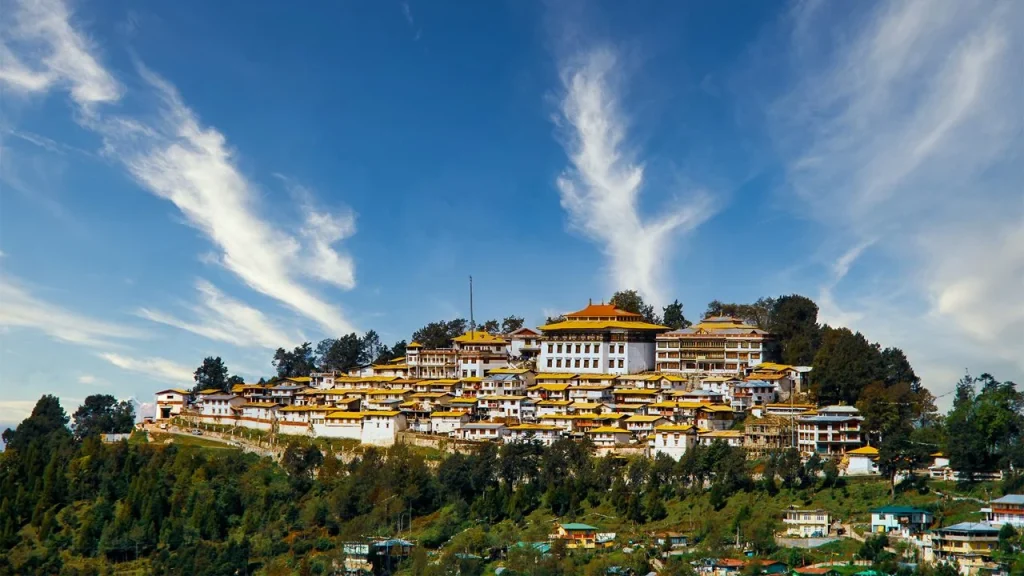
Tawang Monastery looks like a strong fort. It is the largest monastery in India and the second largest in Asia. It was built in 1680–1681 by Merak Lama Lodre Gyatso, following the wishes of the 5th Dalai Lama.
In Tibetan, it is called “Gaden Namgyal Lhatse,” which means the divine paradise of complete victory. The monastery belongs to the Gelugpa school of Buddhism.
Special things about Tawang Monastery
- Birthplace connection: Near the monastery, you can visit Urgelling Monastery, where the 6th Dalai Lama was born.
- Fortress-like building: The monastery looks like a big fort. It has three floors and a long wall (about 925 feet) around 65 houses for monks.
- Big library: It has many old and valuable Buddhist books, including the Kangyur and Tengyur.
- Great location: The monastery is close to the borders of Tibet and Bhutan, which makes it very important.
Travel tips
- Best time to visit: April to October, when the weather is nice and the skies are clear.
- Nearest airport: Tezpur Airport in Assam (about 180 km away).
- Nearest railway station: Rangapara North in Assam (about 160 km away).
- Festivals: The Losar Festival (Tibetan New Year) and the Torgya Festival are celebrated here with colorful mask dances.
- Permits: Visitors need an Inner Line Permit (ILP) to enter Arunachal Pradesh.
Namdroling Monastery (Golden Temple) – Karnataka
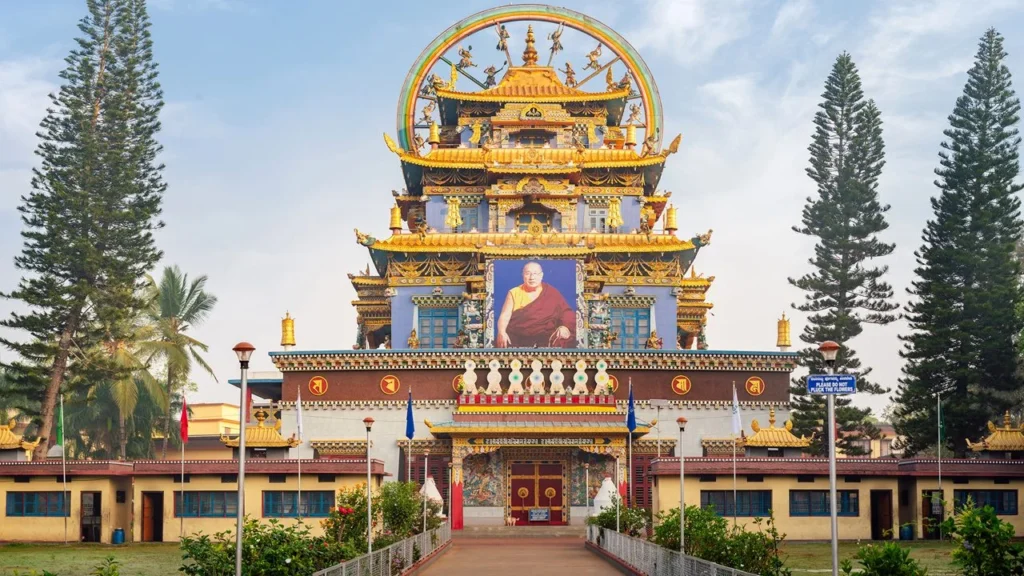
When you step inside Namdroling Monastery in Karnatak, the golden temple shines so bright that it feels magical. This monastery was started in 1963 by His Holiness Pema Norbu Rinpoche, the 11th leader of the Palyul Lineage.
It is one of the largest Tibetan settlements in India, with about 16,000 refugees and 600 monks living there. The monastery is in Bylakuppe, Karnataka, and it shows the strength and spirit of Tibetan Buddhism in exile.
Special things about Namdroling Monastery
- Golden temple complex: The main temple, called Padmasambhava Buddhist Vihara, was completed in 1999. Its golden design and fine carvings make it very beautiful.
- Three great statues: Inside the temple, you will see three huge statues: Buddha in the middle, with Lord Amitayus and Lord Padmasambhava on each side.
- Learning center: This monastery has the largest teaching center in the world for the Nyingma tradition.
- Tibetan culture: It is also a place where you can see Tibetan art, craft, and spiritual practices.
Travel tips
- Timings: Open daily from 9:00 AM to 6:00 PM.
- Distance: About 220 km from Bangalore and 172 km from Mangalore.
- Nearest airport: Mysuru Airport (about 101 km away).
- Stay options: You can find homestays in Kushalnagar and resorts in Madikeri (35 km away).
- Prayer time: Special prayers are held at 1:00 PM.
- Entry fee: No entry fee. It is free for all visitors.
Rumtek Monastery – Sikkim
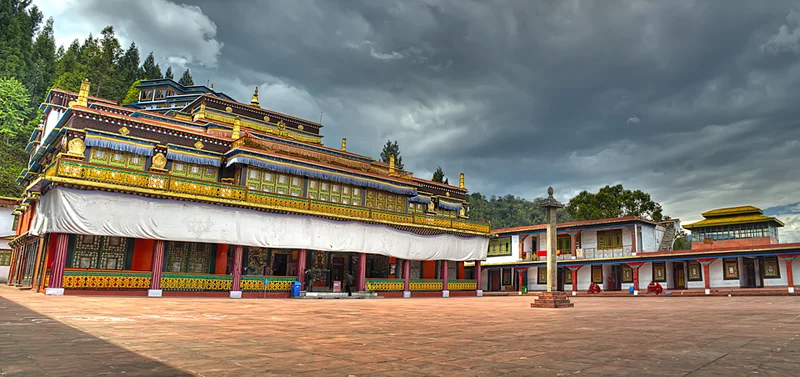
Rumtek Monastery is full of life and prayers. It was first built in the 1700s by the 12th Karmapa. Later, in the 1960s, it was rebuilt by the 16th Karmapa, Rangjung Rigpe Dorje. It is one of the biggest monasteries in Sikkim and the main seat of the Karma Kagyu tradition outside Tibet.
Special things about Rumtek
- Replica design: It looks almost the same as the Tsurphu Monastery in Tibet.
- Golden stupa: Keeps the holy relics of the 16th Karmapa.
- Karma Shri Nalanda Institute: A famous Buddhist school with a 9-year study program.
- Black hat: A sacred hat used by Karmapas during special festivals.
Travel tips
- Location: 24 km from Gangtok, at 1,500 meters height.
- Timings: Open daily from 6:00 AM to 6:00 PM.
- Entry fee: Around Rs. 10–20.
- Best time: October to May.
- Access: A short but steep 10-minute walk from the parking area.
- Festival: Tse Chu festival with colorful ceremonies.
Key Monastery – Himachal Pradesh
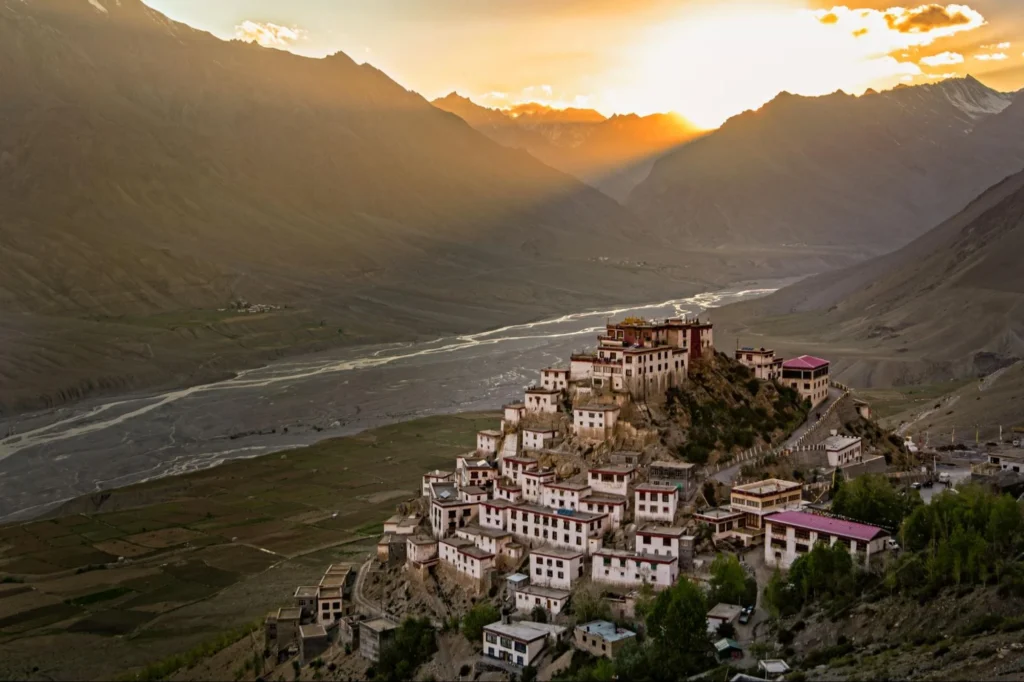
Key Monastery was built in the 11th century by Dromtön, a student of the great teacher Atisha. It is the oldest and largest monastery in Spiti Valley, at a height of 4,166 meters. It follows the Gelugpa (Yellow Hat) tradition.
Special things about Key Monastery
- Fort-like design: Built in Tibetan style, it looks like a castle.
- Learning center: More than 250 monks study both religion and general subjects here.
- Old scrolls: Keep rare Buddhist paintings and manuscripts.
- Cham festival: Famous for its masked dances.
Travel tips
- Altitude: Very high, so acclimatization is needed.
- Best time: May to October.
- Access: Easily reachable from Kaza by road.
- Stay options: Homestays available in nearby villages.
- Photography: Amazing mountain and monastery views.
Mahabodhi Temple – Bihar
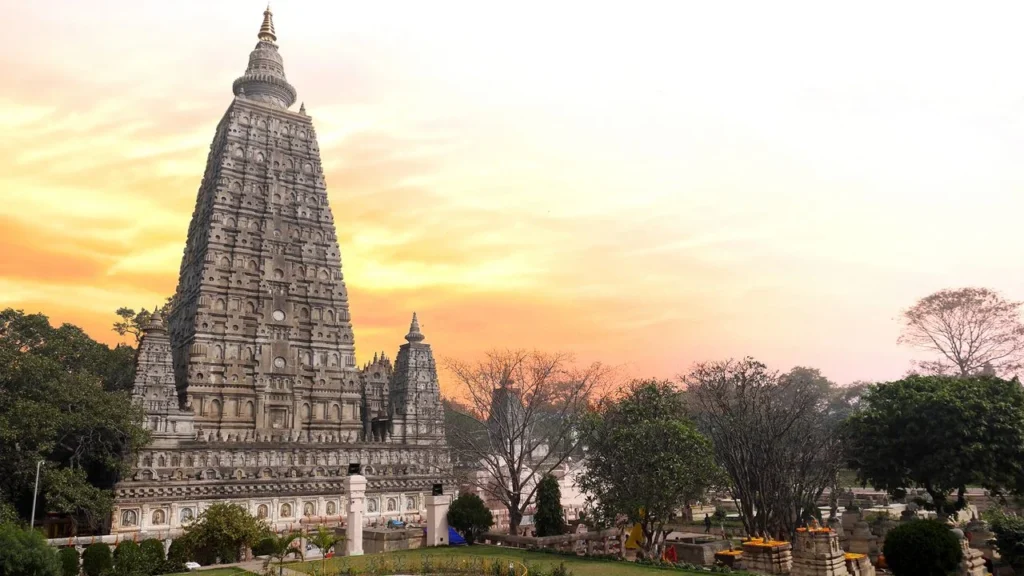
The Mahabodhi Temple is the place where Prince Siddhartha Gautama became the Buddha after meditation under the Bodhi Tree, more than 2,500 years ago. Emperor Ashoka first built a temple here in 260 BCE. Today, it is a UNESCO World Heritage Site and the holiest Buddhist place in the world.
Special things about Mahabodhi Temple
- Bodhi tree: A descendant of the original sacred tree.
- Vajrasana (diamond throne): From the 3rd century BCE, marking the exact spot of enlightenment.
- Main temple tower: 55 meters tall with an ancient design.
- Sacred sites: Seven holy spots linked to Buddha’s enlightenment.
Travel tips
- Location: Bodh Gaya, 15 km from Gaya, 96 km from Patna.
- Airport: Gaya International Airport, 10 km away.
- Best time: October to March.
- Stay options: Many hotels, from budget to luxury.
- Daily worship: Aarti and prayers are held regularly.
- Guides: Recommended for better understanding.
📌 Related: Buddhist Pilgrimage Sites in India: A Complete Guide to Sacred Destinations
Thiksey Monastery – Ladakh

Thiksey Monastery was built in 1430 by Paldan Sherab of the Gelugpa sect. It is called the “Mini Potala” because it looks like the Potala Palace in Lhasa. The 12-story complex has many temples, stupas, and schools.
Special things about Thiksey
- Maitreya Buddha: A 49-foot statue, the tallest in Ladakh.
- Assembly hall: A grand hall with murals and thangkas.
- Education: Around 120 monks live here, along with a nunnery.
Morning prayers: Visitors can join early morning rituals.
Travel tips
- Location: 19 km from Leh, in the Indus Valley.
- Timings: Open 7:00 AM to 7:00 PM.
- Best visit time: 7:00–7:30 AM to see prayer ceremonies.
- Transport: About 30 minutes drive from Leh.
- Photography: Great valley and architectural views.
Mindrolling Monastery – Uttarakhand

Mindrolling was first built in Tibet in 1676 by Rigzin Tendak Lingpa. After Tibet’s troubles, it was rebuilt in Dehradun in 1965 by Khochhen Rinpoche. It is one of the six great monasteries of the Nyingma school.
Special things about Mindrolling
- World’s tallest stupa: 220 feet high and 100 feet wide.
- Five-story building: Has big Buddha and Padmasambhava statues with colorful art.
- Unique design: Mix of Tibetan and Japanese styles.
- Education: Ngagyur Nyingma College, one of the largest Buddhist institutes.
Travel tips
- Timings: Open 9:00 AM to 7:00 PM (closed 12–2 PM).
- Location: Clement Town, Dehradun.
- Best time: Year-round, mild climate.
- Gardens: Beautiful lawns for peace and meditation.
- Library: Huge collection of Buddhist texts.
Shanti Stupa – Ladakh
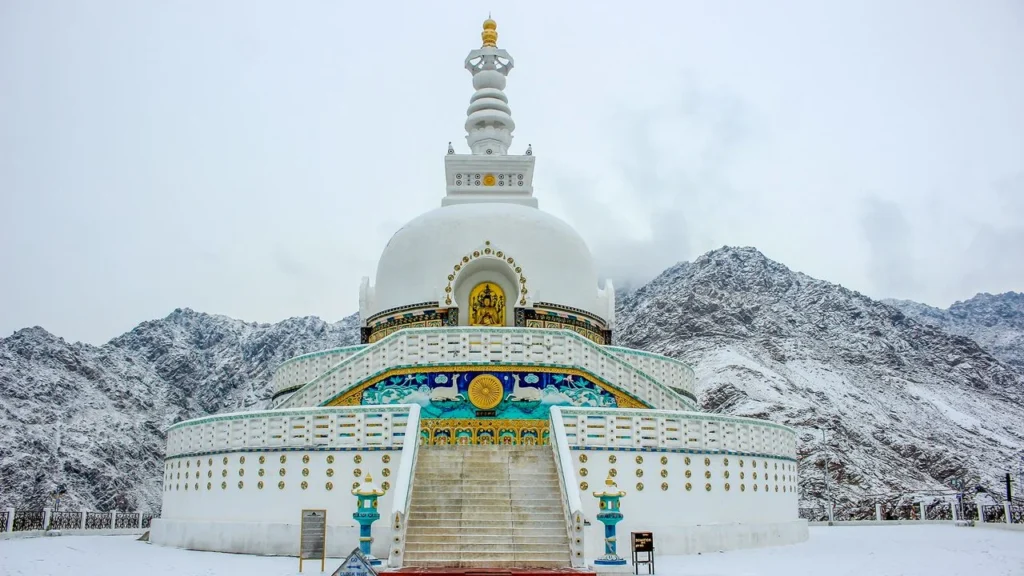
Shanti Stupa was built in 1991 by a Japanese monk, Bhikshu Gyomyo Nakamura. It marks 2,500 years of Buddhism and spreads the message of peace. The 14th Dalai Lama consecrated it and placed Buddha’s relics here.
Special things about Shanti Stupa
- Two levels: The first has a golden Buddha statue, the second shows Buddha’s life.
- Valley views: Offers amazing views of Leh and the Himalayas.
- Night view: Lights make the white dome glow at night.
- Peace symbol: Shows friendship between Japan and Ladakh.
Travel tips
- Location: 5 km from Leh, on Changspa hill.
- Timings: 5:00 AM to 9:00 PM.
- Access: Climb 500 steps or drive to parking.
- Best times: Sunrise and sunset for photos.
- Nearby places: Leh Palace and handicraft markets.
- Entry: Free.
Sarnath Monasteries – Uttar Pradesh

Sarnath is where Lord Buddha gave his first sermon, called Turning the Wheel of Dharma, more than 2,000 years ago. Located 10 km from Varanasi, it is one of the most sacred Buddhist sites.
Special things about Sarnath
- Dhamekha stupa: Marks the exact spot of the first sermon.
- Ashoka pillar: Its lion capital is India’s national emblem.
- Many monasteries: Tibetan, Thai, Japanese, and others.
- Museum: Keeps old Buddhist relics and sculptures.
Travel tips
- Best time: October to March.
- Duration: Spend 2–4 hours exploring.
- Transport: Auto-rickshaw, taxi, or bus from Varanasi.
- Dress code: Wear modest clothes.
- Guides: Useful for history.
- Tour combo: Often paired with Varanasi temples.
📌 Related: Famous Buddhist Temples in India in 2025: Complete Guide
Enchey Monastery – Sikkim
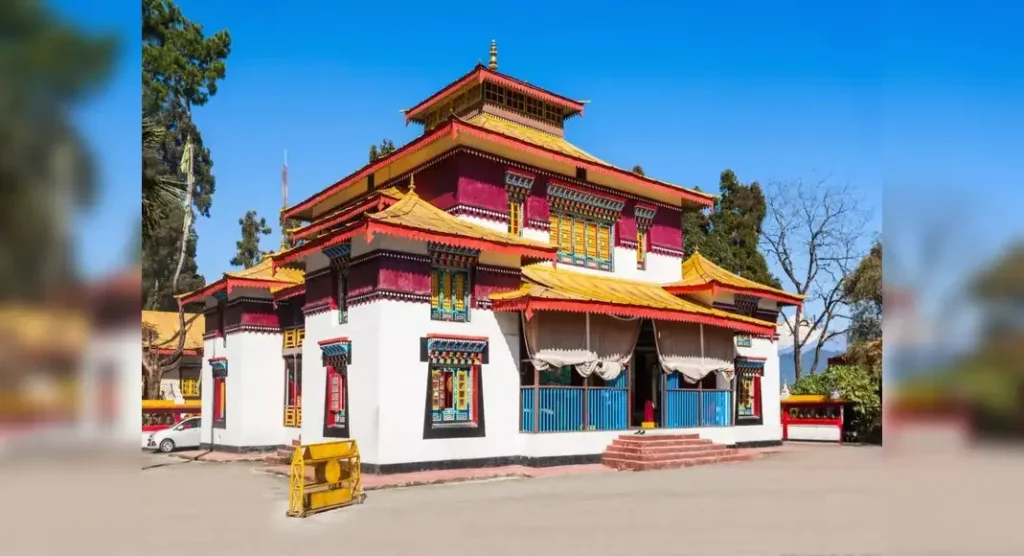
Enchey Monastery was built in 1909 during the rule of Sikyong Tulku. It belongs to the Nyingma order of Buddhism. Lama Drupthob Karpo, a tantric master said to have “flying powers,” blessed this place.
Special things about Enchey
- Pagoda design: Built in Chinese Pagoda style.
- Protective deities: Believed to house local gods Khangchendzonga and Yabdean.
- Festivals: Detour Cham (every year) and Singhe Cham (every 3 years).
- Prayer wheels: 200-meter-long path with spinning prayer wheels.
Travel tips
- Location: 3 km from Gangtok main market.
- Timings: Open 6:00 AM to 6:00 PM.
- Entry: Free.
- Access: Easy drive from Gangtok-Nathula road.
- Best views: Great Kanchenjunga mountain views.
- Festivals: Visit in Jan–Feb for Detour Cham.
Dzongkar Choede Monastery – Karnataka
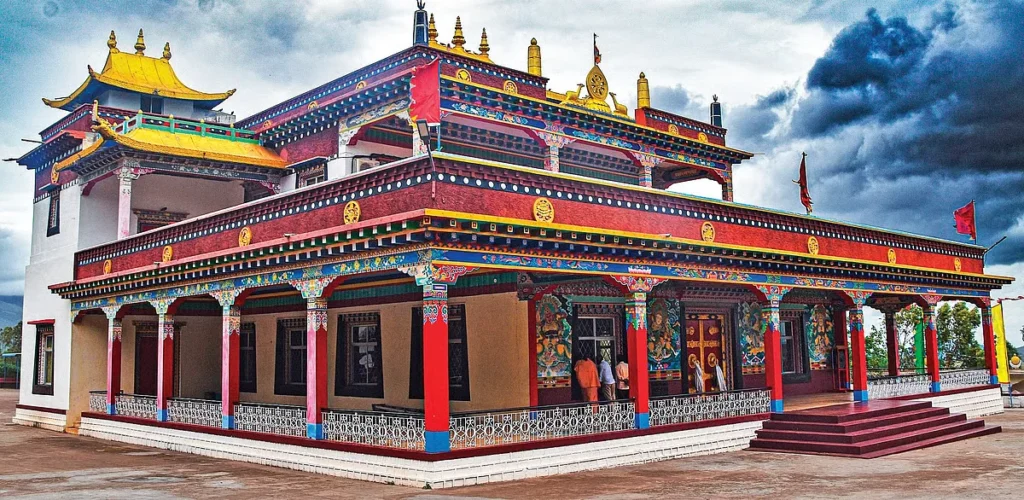
Dzongkar Choede was first built in 1270 by a Tibetan king. It was destroyed during China’s Cultural Revolution but was rebuilt in Hunsur, Karnataka in 1971 with help from the Dalai Lama and Indian government.
Special things about Dzongkar Choede
- Cultural traditions: Monks keep alive rituals like chanting, mask dances, butter sculptures, and sand mandalas.
- Education: Monastery runs schools for young monks and art classes.
- Community: About 300 monks live here, including 190 student monks.
- Crafts: Incense-making and thangka painting workshops.
Travel tips
- Location: 12 km from Hunsur, 57 km from Mysore.
- Puja times: 5–6 AM and 5–6 PM.
- Entry: Free, no parking fee.
- Festival: Cham dances in Dec–Jan.
- Cultural programs: Open to all visitors.
- Transport: From Hunsur, take SH86.
Drepung Monastery – Karnataka

Drepung was first built in Tibet in 1416 by Jamyang Choje Tashi Palden. It was once the world’s largest monastery with 8,000 monks. After 1959, it was re-established in Mundgod, Karnataka, in 1970.
Special things about Drepung
- “Rice heap” design: White buildings stacked on hillsides look like rice heaps.
- Four colleges: Gomang, Loseling, Deyang, and Shagkor for Buddhist studies.
- Dalai Lama link: Early Dalai Lamas stayed here.
- Education: Follows debate and detailed study system.
Travel tips
- Location: Mundgod, Karnataka.
- Academic schedule: Classes 6 days a week, with daily debates.
- Visitor access: Limited timings due to education.
- Significance: Important for understanding Buddhist learning.
- Transport: Well-connected to major Karnataka cities.
Why visit a Buddhist monastery?
For me, monasteries aren’t just about religion. They’re more than that. They’re about experience.
The moment you step inside, it feels like the world slows down. The chants, the smell of incense, the sight of monks in their maroon robes, it all moves to a rhythm that’s different from everyday life.
- Peace and stillness: Even if you don’t meditate, just sitting quietly can calm your mind.
- Culture and history: Every monastery has stories, murals, and traditions that go back centuries.
- Community: You’ll often meet monks, travelers, or locals who are warm and welcoming.
- Scenic beauty: No need to define, as any monasteries in India are built in the most breathtaking valleys and hilltops.
If you ask me, visiting a Buddhist monastery is less about sightseeing and more about feeling something deeper within.
Travel tips from my own experience
I’ve visited monasteries many times, sometimes alone, sometimes with groups. Here are a few lessons I’ve picked up along the way:
- Dress modestly: Avoid shorts or revealing clothes.
- Silence is golden: Keep your voice low and respect the calm.
- Check photography rules: Always ask before taking photos, especially of monks or rituals.
- Carry cash: Remote monasteries don’t always have ATMs or card facilities.
- Join a prayer session: If you get the chance, sit quietly during the chanting. Even if you don’t understand the words, the vibration stays with you. This one is my fav.
- Respect boundaries: Some areas are for monks only. Follow signs or instructions.
Go with an open heart, and I promise you’ll return with more than just photos. You’ll carry a sense of peace that lingers long after your trip.
So, where do you want your Buddhist journey to begin?
When I first started visiting monasteries, I thought I was just seeing temples. But after a while, I realized it’s not only about walls, statues, or prayer flags, it’s about the feeling. That stillness you carry with you, even after you’ve left.
If you’re reading this and thinking, “This sounds amazing, but planning it all sounds like a headache,” don’t worry. That’s exactly why we started the Varanasi Excursion. We make the journey simple, so you can focus on the experience.
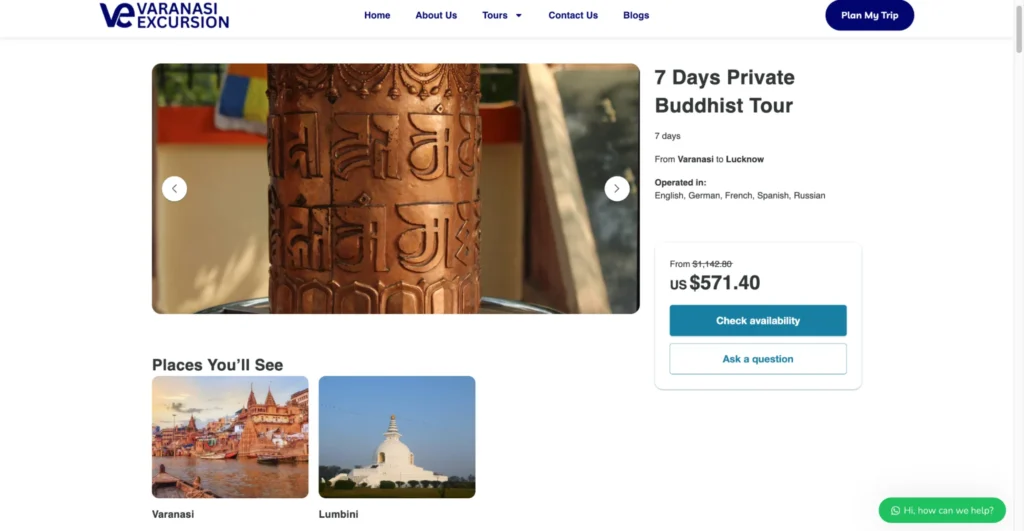
👉 Our 7-Day Private Buddhist Tour is perfect if you want a shorter trip filled with monasteries, sacred sites, and hidden gems.
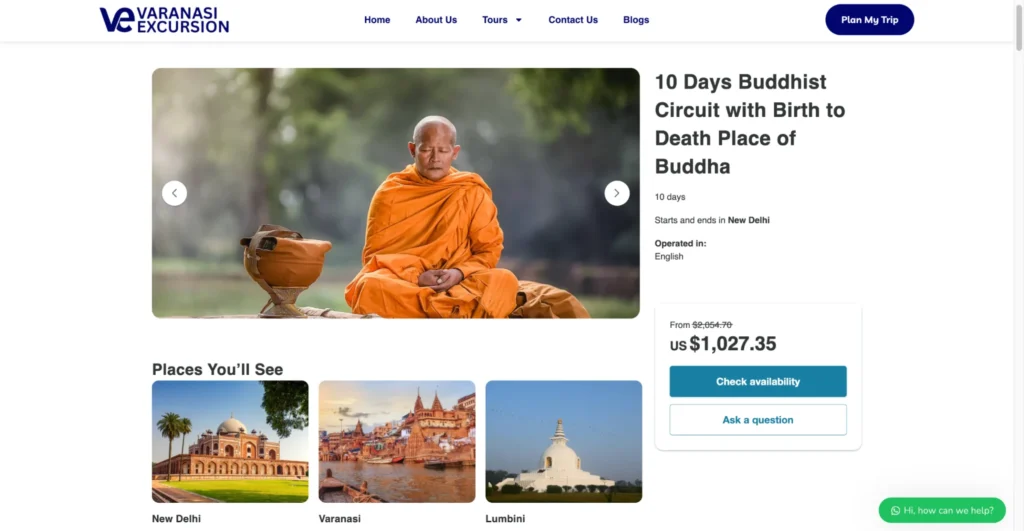
👉 Our 10-Day Buddhist Circuit Tour takes you through the full story of Buddha’s life. From his birthplace in Lumbini to the place of enlightenment in Bodh Gaya and his Mahaparinirvana at Kushinagar.
👉 And if you have your own idea of the perfect journey, we also design customized Buddhist tours, just for you. All you need to do is just call us at +91 9005104999.
From transport to guides to stays, we handle everything. All you need to do is bring your curiosity (and maybe a good pair of walking shoes).
And here’s one little tip if you’re coming from outside India: some Buddhist trails cross into Nepal. To visit Lumbini, the Buddha’s birthplace, you’ll need a double-entry Indian visa. It’s a small step that saves you a big headache later.
So, if 2025 is the year you finally want more than just a holiday, if you want a journey that stays with you, maybe it’s time.
Your Buddhist trail is waiting. 🌿
Namo Buddhaya 🙏

